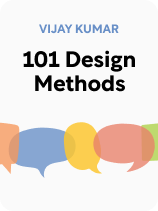

This article is an excerpt from the Shortform book guide to "101 Design Methods" by Vijay Kumar. Shortform has the world's best summaries and analyses of books you should be reading.
Like this article? Sign up for a free trial here.
What is a product workshop? What workshop activities can help you through the innovation process?
According to Vijay Kumar’s book 101 Design Methods, a product workshop can help your business team brainstorm innovative ideas for new products. Workshopping products is a great way of getting the team to work together, while also scouting out users who may be interested in what you’re selling.
Let’s break down the fundamentals of what makes a product workshop effective.
How to Hold Product Workshops
Kumar discusses a number of product workshop activities that can be helpful at various stages of the innovation process:
- Develop a clear idea of what you intend to accomplish
- Define your operating environment
- Understand your stakeholders
- Develop a mental model
- Brainstorm solution elements
- Assemble and evaluate comprehensive solutions
- Plan to implement the solution
In Task 3, where you’re working to understand how your prospective users think and feel about things, Kumar recommends compiling a folder of photographs showing a variety of people and items in different situations. Then, set up a workshop where you ask users to organize the photos thematically or arrange them into a sequence that tells a story. When they’ve finished, have them explain their choices to you. This may reveal feelings or associations they harbor that you would’ve overlooked otherwise.
For example, maybe you ask them to pick out photos they would associate with good customer service versus bad customer service. You might notice that the “good” photos they pick out are all brightly colored, while the “bad” photos tend to show drab, sterile, office settings. This reveals something about how the setting in which their service needs are addressed impacts how they feel about the service.
(Shortform note: Kumar points out that using photos in workshop activities can give you additional insight into how people think and feel about things or associations that they draw between them. In Brain Rules, John Medina observes that vision is your dominant sense, which may explain why photos or other visual aids can help to bring additional insights to the surface: More of your brain is devoted to processing visual information than to any other sense. As such, images often evoke more vivid impressions and associations than other stimuli, like written statements or survey questions.)
Similarly, in Task 3, Kumar suggests designing workshop exercises to incorporate cultural artifacts—things that have social significance in a particular culture. For example, maybe a certain card game is widely popular within a certain culture. So, at a workshop designed to engage users from that culture, you pass out decks of cards and ask them to select a card that expresses how they feel about the purchasing process, the user interface, and other aspects of the product or how they interact with it. Their responses will give you insight into their culture and how it colors the user experience.
(Shortform note: Be careful how you use cultural artifacts so you don’t offend your workshop participants. In So You Want to Talk About Race, Ijeoma Oluo describes ‘cultural appropriation’ as a form of microaggression that people from marginalized races or cultures often face. Cultural appropriation is when someone from one culture (especially a dominant culture) makes use of something that has symbolic significance in another culture (especially a marginalized culture) without properly understanding its significance or giving due credit to the culture that originated it. As such, making use of cultural artifacts in a workshop without fully understanding their origins and symbolic significance runs the risk of offending workshop participants through cultural appropriation.)
In Task 5, Kumar says sometimes you can make your brainstorming sessions more effective by turning them into a game. For example, you might create several decks of cards: one that lists a user profile on each card, one that lists a certain aspect of the product on each card, one that specifies a certain use case for the product, and one that specifies a certain stage of the product life cycle. Players are dealt a random assortment of cards from all four decks and get points for coming up with unique solutions for the situations represented by their cards.
| Optimizing Your Games With the advent of the video game industry, game design has itself become a field of active research. If you decide to use games as workshop activities and to generally boost productivity, it may be worth your while to study game design theory so that you can make your games effective. In A Theory of Fun for Game Design, game developer Raph Koster postulates that, fundamentally, games are fun because they give you the opportunity to learn new “patterns” in an environment where the consequences of failure are smaller than in real life. By “patterns” he means skills, behavioral patterns, or principles of nature—especially those that enable you to predict events, increase your social status, increase your power over your environment, or other things that, at least historically, enhanced human survival. He says humans have evolved to enjoy learning these patterns. But when the stakes are high, we often prefer comfort and security over the fun of experimenting and learning new things. Games exploit this principle by allowing us to learn new patterns that affect the outcome of the game but don’t have significant consequences in real life. Since all of Kumar’s innovation Tasks involve either learning about patterns or developing new ways to generate value, entire innovation projects could arguably be construed as large, complex games, based on Koster’s theory. In this light, perhaps the key to stimulating performance on these projects is to ensure that the consequences of failure are minimal. Some of the strategies we’ve discussed up to now (like building MVPs) are designed to do just that by keeping costs low until you know you have a winning product. |

———End of Preview———
Like what you just read? Read the rest of the world's best book summary and analysis of Vijay Kumar's "101 Design Methods" at Shortform.
Here's what you'll find in our full 101 Design Methods summary:
- Why many companies don’t understand how to manage innovation
- A systematic approach to innovation management
- Specific tools and techniques you can use on innovation projects






